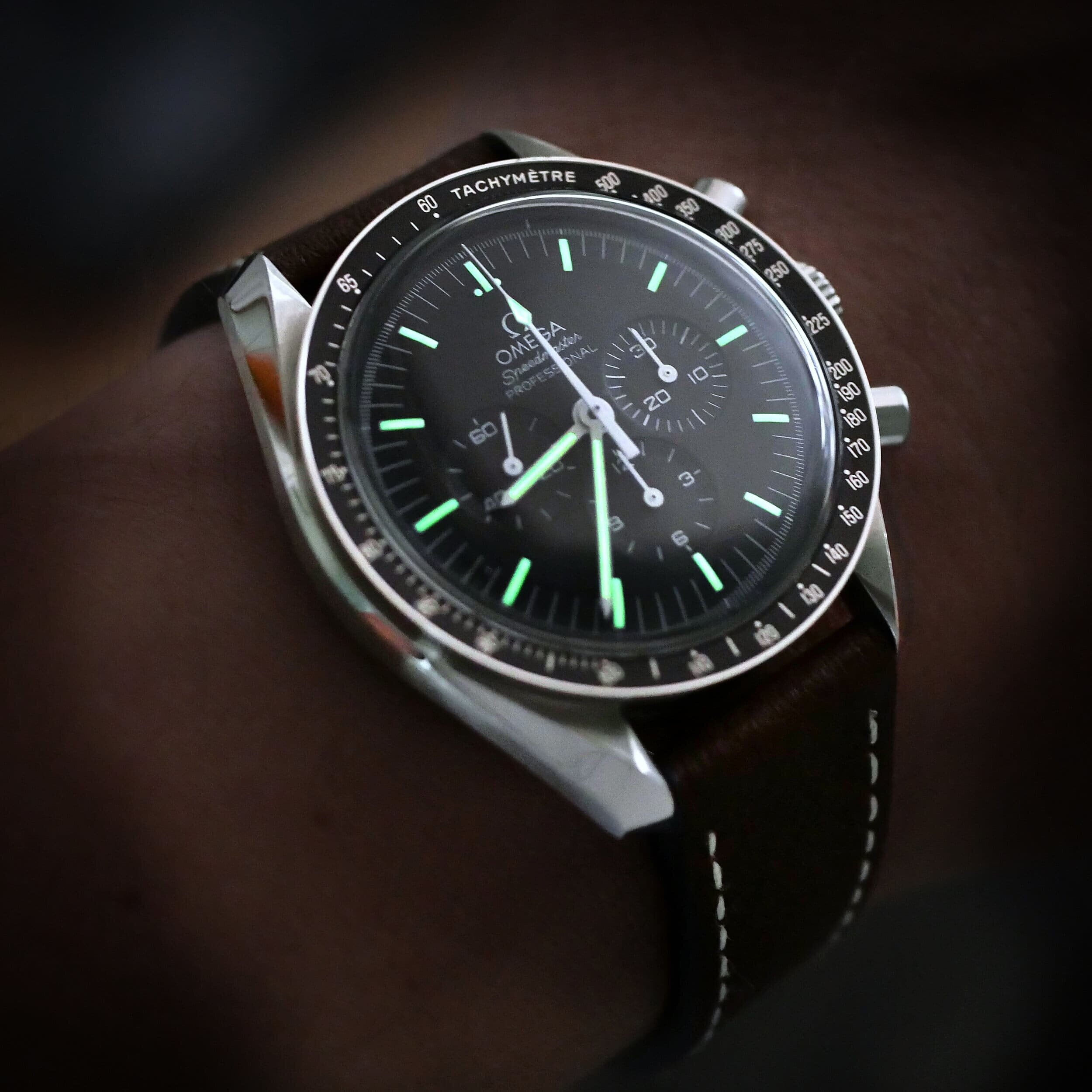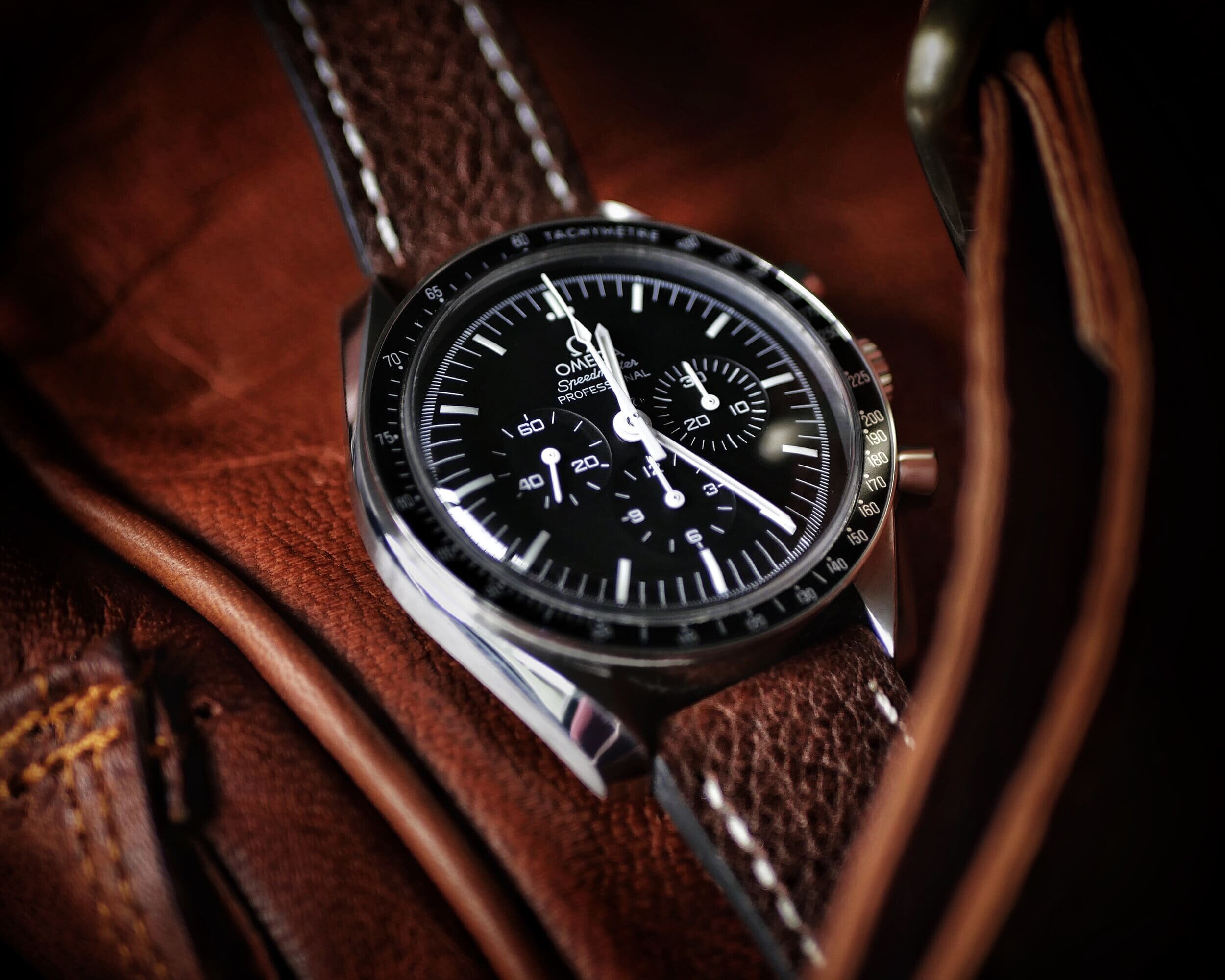Omega Speedmaster Professional review
This article may contain affiliate links which means if you choose to purchase a product using the link I may get a small commission. This is at no extra cost to yourself and enables me to keep writing reviews of watches and products I genuinely think you will enjoy or find useful.
Omega Speedmaster Professional a modern Icon
The Omega Speedmaster has to be one of the most Iconic pieces in watchmaking history. Steeped in a strong history and with variations and special editions that have had books written about them, it must be one of the most well known and well-recognised pieces of the last seventy years. The manual winding original Speedmaster Professional is probably the best known of all the varieties and the gateway for many into the Speedmaster line of watches. With the Speedmaster, Omega shot for the stars and quite literally went to the moon. This article covers the basics of the watch and hopefully helps you understand the appeal of this iconic watch from Omega.
A Brief History
Omega first released the Speedmaster line of chronograph watches in 1957. Still, it wasn't until NASA’s Gemini 4 mission of 1965 and the later Apollo 11 mission to put the first man on the moon that the Speedmaster Professional’s reputation quite literally skyrocketed. NASA certified the Speedmaster Professional for spaceflight and in that moment cemented its place in history. To this day the Speedmaster Professional is still only one of several watches officially certified for spaceflight and the only one approved by them for extravehicular activity (or spacewalks for us earthbound folks. The culmination of this is the faithful Apollo 11 mission landing on the moon back in July of 1969 and Buz Aldrin stepping onto the moon wearing his Speedmaster. The Speedmaster Professional has been known as the moon watch ever since.
Fast Forward to today
Today's Moon watches are very similar to that original piece, albeit with slightly more modern but still hand-wound movements. And again, carry that air of adventure and this has to be one of the appeals of the watch. The Speedmaster has not only stood up to the rigours of space travel and landed on another planet, but it's stood the test of time here on little old Earth too. Sales have always been strong with the Speedmaster, obviously in part due to the story and history behind it but also because even without those things, the Speedmaster professional is a very good watch. Never primarily developed for spaceflight, the Speedmaster was meant to be a chronograph for sport and racing. Still, it has a case and design style that can very easily be dressed up or down, making it a fantastic watch for most occasions.
Speedmaster Professional Basics
So what do you get with the Speedmaster Professional? Well, first off, you get that iconic case in stainless steel with those charming signature twisted lugs. The case on the Speedmaster is done very nicely with a mix of high polish and very finely brushed finishes. The case on the Speedmaster Professional sits at 42mm in diameter, which for me, is a very nice size. If that sounds big for you, please try one before it puts you off, as it does wear well thanks to those short lugs very nicely. It also has a 20mm lug width which I find is far and away my favourite width for straps and makes finding straps a breeze. As standard, it comes on a very well-made stainless steel bracelet but also included is a replica of the Velcro NATO strap from the moon mission if you fancy playing astronaut for the day! As well as a pure black Omega signed standard NATO strap.
The Bezel on the Speedmaster is night-sky black with a tachymeter scale for measuring speed. And that famous chronograph dial is also in black featuring a small seconds dial, a 30-minute recorder and a 12-hour recorder with a central chronograph hand. Just below the noon position, you have the text Omega Speedmaster Professional, and then the simple baton-shaped markers all filled with SuperLuminova. The look of the stark black dial and the crisp white markers and printing in itself reminds you of the night sky. And the SuperLuminova does a fantastic job of keeping every detail on the dial legible when the night arrives. Chronograph watches can sometimes look cluttered and altogether too busy sometimes, especially when they become too highly stylized. With the Speedmaster Professional, they have kept things simple, and there is a certain elegance with that. It's not an overstated dial or watch in general. Its form following function, which probably lends to its appeal in many ways as well as its practicality.
Sitting on top of the dial is a Hesalite crystal which is touted to have been one of the many determining factors to it gaining NASA certification way back in its history. One of the main benefits of the Hesalite is its shatterproof nature, and this is very important when you will be sitting in a massive rocket blasting off into space and spending much of the journey in zero gravity. Having shards of sapphire crystal floating around the crew compartment was a big no-no from NASA should one of the astronauts have had an accident and smashed the watch. Although you lose the scratch resistance with having the Hesalite as opposed to sapphire, I find the crystal gives such a warm vintage glow in the right light, and it's also far easier to maintain. Yes, sapphire won't scratch, but if it breaks, it's a significant expense to replace. With Hesalite, all but the very deepest scratches can be polished out. I probably polish my crystal once every few months, and within a few minutes, it's as good as new. The Hesalite can also provide some fantastic dial distortion at certain viewing angles again, it is a nice throwback to the decades-ago pieces the astronauts would have strapped on their wrists before blasting off into the history books.
Always perfectly legible
The case back on the Speedmaster Professional is also simple but very nicely executed, with engraved text calling out the NASA certification and proudly stating that this was the first watch worn on the moon. The center of the case back is reserved for the iconic hippocampus and omega logo engraving, which, again, as with all the details on the Speedmaster Professional, is very expertly done. The case back on the Speedmaster is screw-down, and this gives a water resistance of 50 meters. This isn't a dive watch, but for most everyday situations, this should be fine. If you work in or around water or want to go swimming or diving, then the Speedmaster is probably not the right choice for those activities.
Inside the case of the Speedmaster professional sits mechanical calibre 1861, which is a manual wind movement so this is as close to the original in terms of function as you can get. Omega also produces automatic versions if you would prefer, but for me, the purity of the hand-wound movement is again one of the things that drew me to the piece. There is a particular ritual that goes with having to wind this watch and be connected to it in a way that is, well, just appealing. In a modern digital world with automatic updates to phones and laptops, digital watches, and the myriad of other advances around us, sometimes it's nice to have that mechanical connection to something as historic as this watch and know that back then those astronauts would have wound these watches in space on their journey to the Moon. Besides, it's far from difficult, and a full wind will give 48 hours of power reserve which I find is plenty, and tend to get into a routine of winding the watch each morning or evening as a kind of ritual.
Operating the chronograph function of the movement is the two pushers on the right-hand side of the dial. The top pusher acts as the stop and start, and the bottom pusher is the reset. It's simple to use and has a very satisfying action to the pushers. The Chronograph function is probably one of the more useful complications in a watch and was critical to those astronauts who had very complicated and time-critical activities that demanded precision to be done right. These were, in most cases, life-or-death situations, so it goes to show the faith they put in this watch. Most people, don't face those sorts of split-second timing pressures, but I still use the function regularly for everything from boiling an egg to workouts. As watch complications go, most people will find a chronograph function more useful than they initially thought.
Presentation
The Speedmaster Professional comes in a very nice flight case with numerous extra bits and pieces that make up the overall package:
A decorative paperweight engraved with the hippocampus like the case back
A tool for changing the strap
A loupe again with the tachymetric scale around the glass
A black polyamide NATO strap with stainless steel hardware
A Velcro strap which is a rendition of the one that was worn by the Apollo astronauts, including NASA reference numbers and codes relating to those missions
An instruction manual and an excellent book that highlights those missions and some lovely photography of them.
From a presentation standpoint, Omega always does a stellar job. Everything is branded and exceptionally well made and follows the ethos of the space missions this watch was used for. Opening the box, you can imagine receiving this on the eve of a mission, and it all goes a long way to making you feel part of that experience and moment. The book they provide contains some beautiful images and information all on its own and is well worth the read, and the additional strap option also allows you to dress down the watch to make it look a little more casual. Overall I feel what Omega provides with The Speedmaster Professional is a very well-rounded and useful package that hits the mark. They have historical information as well as valuable items that will make a living with the Speedmaster a Joy.
The Speedmaster works well with a variety of straps
Conclusion
The Omega Speedmaster line of watches for many watch enthusiasts is instantly recognisable. What Omega accomplished with the Speedmaster professional is bridging a gap between watch enthusiasts and people who have maybe never really looked into watches before. The Speedmaster Professional is forever to be known as the Moon watch, and everybody knows and understands the hardship and accomplishment that those men went through and achieved to go to the moon. Watches with stories attached, and this is one of many tend to resonate with people and their spirit of adventure. They allow people to share in that adventure in some small way, and that is not restricted just to watch lovers when the story is an accomplishment that was a step as monumental as going to the moon.
Owning a Speedmaster Professional has been a Joy for me. It's a watch that will never leave my collection, even if I look at other versions. It was the first watch on the Moon, and who knows when it will go back. If you want a watch that signifies an important milestone in your life or a personal achievement accomplished, then I'm hard-pressed to think of a piece that embodies that more than the Speedmaster Professional.
Looking for your own Omega Speedmaster Professional check the range and availability here
Specifications
lugs width: 20 mm
Bracelet: steel
Case: Steel
Case diameter: 42 mm
Dial colour: Black
Crystal: Hesalite crystal
Water resistance: 50 metres
Movement: Hand wound mechanical Omega 1861










